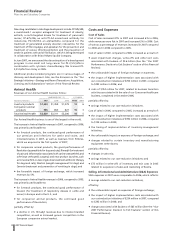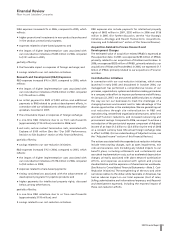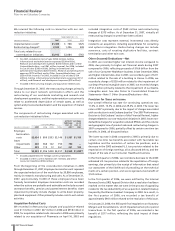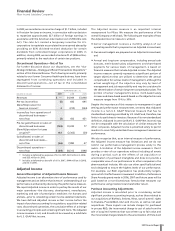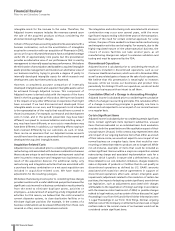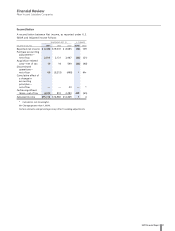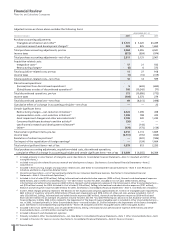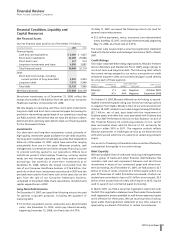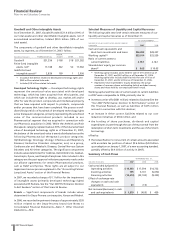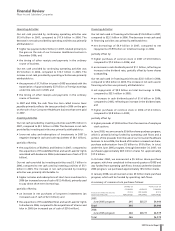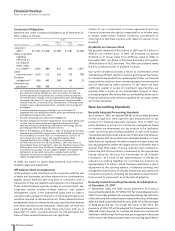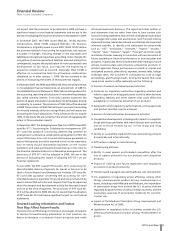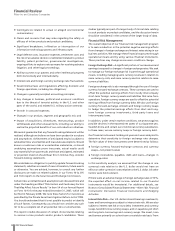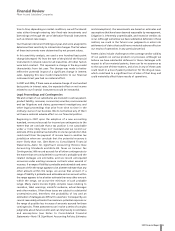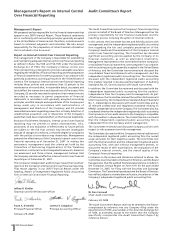Pfizer 2007 Annual Report Download - page 34
Download and view the complete annual report
Please find page 34 of the 2007 Pfizer annual report below. You can navigate through the pages in the report by either clicking on the pages listed below, or by using the keyword search tool below to find specific information within the annual report.
32 2007 Financial Report
Financial Review
Pfizer Inc and Subsidiary Companies
Contractual Obligations
Payments due under contractual obligations as of December 31,
2007, mature as follows:
YEARS
___________________________________________________________
OVER 1 OVER 3
(MILLIONS OF DOLLARS) TOTAL WITHIN 1 TO 3 TO 5 AFTER 5
Long-term
debt(a) $11,203 $1,358 $1,498 $1,061 $7,286
Other long-term
liabilities
reflected on
our balance
sheet under
U.S. GAAP(b) 3,407 480 615 635 1,677
Lease
commitments(c) 1,518 212 343 175 788
Purchase
obligations(d) 826 403 248 142 33
Uncertain tax
positions(e) 408408———
(a) Our long-term debt obligations include both our expected
principal and interest obligations. Our calculations of expected
interest payments incorporates only current period assumptions
for interest rates, foreign currency translations rates and hedging
strategies. (See Note 10. Financial Instruments.) Long-term debt
consists of senior, unsecured notes, floating rate, unsecured notes,
foreign currency denominated notes, and other borrowings and
mortgages.
(b) Includes expected payments relating to our unfunded U.S.
supplemental (non-qualified) pension plans, postretirement plans
and deferred compensation plans.
(c) Includes operating and capital lease obligations.
(d) Purchase obligations represent agreements to purchase goods and
services that are enforceable and legally binding and include
amounts relating to advertising, information technology services
and employee benefit administration services.
(e) Reflects the adoption as of January 1, 2007, of Financial Accounting
Standards Board (FASB) Interpretation No. 48 (FIN 48), Accounting
for Uncertainty in Income Taxes, an interpretation of SFAS 109,
Accounting for Income Taxes, and supplemented by FASB
Financial Staff Position FIN 48-1, Definition of Settlement
of FASB Interpretation No. 48, issued May 2, 2007, (see Notes to
Consolidated Financial Statements—Note 1D. Significant Accounting
Policies: New Accounting Standards). Except for amounts reflected
in Income taxes payable, we are unable to predict the timing of tax
settlements, as tax audits can involve complex issues and the
resolution of those issues may span multiple years, particularly if
subject to negotiation or litigation.
In 2008, we expect to spend approximately $2.0 billion on
property, plant and equipment.
Off-Balance Sheet Arrangements
In the ordinary course of business and in connection with the sale
of assets and businesses, we often indemnify our counterparties
against certain liabilities that may arise in connection with a
transaction or that are related to activities prior to a transaction.
These indemnifications typically pertain to environmental, tax,
employee and/or product-related matters, and patent
infringement claims. If the indemnified party were to make a
successful claim pursuant to the terms of the indemnification, we
would be required to reimburse the loss. These indemnifications
are generally subject to threshold amounts, specified claim periods
and other restrictions and limitations. Historically, we have not
paid significant amounts under these provisions and, as of
December 31, 2007, recorded amounts for the estimated fair
value of these indemnifications are not significant.
Certain of our co-promotion or license agreements give our
licensors or partners the rights to negotiate for, or in some cases
to obtain, under certain financial conditions, co-promotion or
other rights in specified countries with respect to certain of our
products.
Dividends on Common Stock
We declared dividends of $8.2 billion in 2007 and $7.3 billion in
2006 on our common stock. In 2007, we increased our annual
dividend to $1.16 per share from $0.96 per share in 2006. In
December 2007, our Board of Directors declared a first-quarter
2008 dividend of $0.32 per share. The 2008 cash dividend marks
the 41st consecutive year of dividend increases.
Our current dividend provides a return to shareholders while
maintaining sufficient capital to invest in growing our businesses.
Our dividends are funded from operating cash flows, our financial
asset portfolio and short-term commercial paper borrowings and
are not restricted by debt covenants. To the extent we have
additional capital in excess of investment opportunities, we
typically offer a return to our shareholders through a stock-
purchase program. We believe that our profitability and access to
financial markets provide sufficient capability for us to pay current
and future dividends.
New Accounting Standards
Recently Adopted Accounting Standards
As of January 1, 2007, we adopted FIN 48, which provides guidance
on the recognition, derecognition and measurement of tax
positions for financial statement purposes. Prior to 2007, our
policy had been to account for income tax contingencies based
on whether we determined our tax position to be ’probable’
under current tax law of being sustained, as well as an analysis
of potential outcomes under a given set of facts and circumstances.
FIN 48 requires that tax positions be sustainable based on a ’more
likely than not’ standard of benefit recognition under current tax
law, and adjusted to reflect the largest amount of benefit that is
greater than 50% likely of being realized upon settlement,
presuming that the tax position is examined by the appropriate
taxing authority that has full knowledge of all relevant
information. As a result of the implementation of FIN 48, we
reduced our existing liabilities for uncertain tax positions by
approximately $11 million, which has been recorded as a direct
adjustment to the opening balance of Retained earnings, and
changed the classification of virtually all amounts associated with
uncertain tax positions, including the associated accrued interest,
from current to noncurrent, as of the date of adoption.
Recently Issued Accounting Standards, Not Adopted as
of December 31, 2007
In September 2006, the FASB issued Statement of Financial
Accounting Standards No. 157 (SFAS 157), Fair Value Measurements.
SFAS 157 provides guidance for, among other things, the definition
of fair value and the methods used to measure fair value. In February
2008, the FASB issued FASB Staff Position (FSP) 157-2 Effective Date
of FASB Statement No. 157. Under the terms of FSP 157-2, the
provisions of SFAS 157 will be adopted for financial instruments in
2008 and, when required, for nonfinancial assets and nonfinancial
liabilities in 2009 (except for those that are recognized or disclosed
at fair value in the financial statements on a recurring basis). We do


